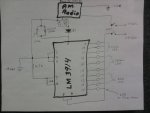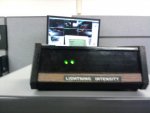elephant
Member
- Joined
- Jan 29, 2003
- Messages
- 131
My Schematic for home brew lightning detector
For those who requested, this is the diagram for building a lightning detector. Be aware, my artistic abilities leave much to be desired. That being said, this detector is by no means a professional piece of equipment. It simply will show you how strong the lightning strikes are. The more LED's that come on, usually indicated a strong storm or one that is close by. Sensativity is adjusted by the volume of the radio. You'll have to play around with it and adjust it to your liking. I waited until a strong storm was very near, then adjusted the volume of the radio so all the LED's came on pretty much constant. At this level, it still detects lightning from storms that are a good 75 miles away.
The radio can be any cheapo AM. I got mine at Radio Shack for a few buck. It should be tuned to the lowest part of the dial without picking up a station. In Phoenix, we have a station at 550, so I had to make a slight modification on the tuner. Hopefully, you won't.
I labeled all the parts as best I can. Make sure that the capacitor is an electrolytic. A ceramic or tantilum won't work. 2.2 microfards rated at 25vdc works really well. The diode can be any common germanium or silicon.
On the diagram, I put 9vdc for the power. I found out that a 9 volt battery drains pretty fast. So, I changed that to 4 AA batteries. They last a lot longer.
I enclosed the whole project into an old Heathkit clock cabinet. The smoked front nicely hides my poor excuse for a circuit board that mounts the LED's. You can see, the 2nd picture shows the finished product.
Anyway, it's a fun project to do. Use your imagination!!!!!! I'm sure someone out there can out do me on the design. I'd be glad to hear of any improvements you can think of.
Doug
For those who requested, this is the diagram for building a lightning detector. Be aware, my artistic abilities leave much to be desired. That being said, this detector is by no means a professional piece of equipment. It simply will show you how strong the lightning strikes are. The more LED's that come on, usually indicated a strong storm or one that is close by. Sensativity is adjusted by the volume of the radio. You'll have to play around with it and adjust it to your liking. I waited until a strong storm was very near, then adjusted the volume of the radio so all the LED's came on pretty much constant. At this level, it still detects lightning from storms that are a good 75 miles away.
The radio can be any cheapo AM. I got mine at Radio Shack for a few buck. It should be tuned to the lowest part of the dial without picking up a station. In Phoenix, we have a station at 550, so I had to make a slight modification on the tuner. Hopefully, you won't.
I labeled all the parts as best I can. Make sure that the capacitor is an electrolytic. A ceramic or tantilum won't work. 2.2 microfards rated at 25vdc works really well. The diode can be any common germanium or silicon.
On the diagram, I put 9vdc for the power. I found out that a 9 volt battery drains pretty fast. So, I changed that to 4 AA batteries. They last a lot longer.
I enclosed the whole project into an old Heathkit clock cabinet. The smoked front nicely hides my poor excuse for a circuit board that mounts the LED's. You can see, the 2nd picture shows the finished product.
Anyway, it's a fun project to do. Use your imagination!!!!!! I'm sure someone out there can out do me on the design. I'd be glad to hear of any improvements you can think of.
Doug



